

How Digital Equity Can Help Close the Homework Gap. Networking & Wireless How Digital Equity Can Help Close the Homework Gap According to a CoSN survey, 82 percent of school districts don't have a plan to address students' Internet access outside of school.

That needs to change. By Keith R. Krueger, Marie Bjerede09/10/15 Does educational technology close the achievement gap or widen it? Unfortunately, educational technology leaders often see only the best-case scenario. First, many describe digital learning as an amplifier of teaching, especially in our increasingly mobile world. Second, the promise of 1-to-1 and bring your own device (BYOD) strategies enables changes in teaching and learning. Third, while school culture has a critical impact on whether educational technology is accessible and how it is used, so does home culture. Fourth, the homework gap affects both individual students and entire classrooms and buildings. Having even a single student who lacks home broadband access perpetuates the homework gap. Failure is for the privileged.
This past week I attend the Infosis CrossRoads Institute.
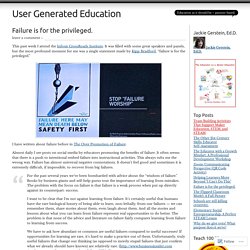
It was filled with some great speakers and panels, but the most profound moment for me was a single statement made by Kipp Bradford, “failure is for the privileged.” I have written about failure before in The Over Promotion of Failure: Almost daily I see posts on social media by educators promoting the benefits of failure. It often seems that there is a push to intentional embed failure into instructional activities. This always rubs me the wrong way. For the past several years we’ve been bombarded with advice about the “wisdom of failure.” Mr. Not everyone “gets” to fail.
Feedback In Lieu of Grades. Feedback In Lieu of Grades. 250 Influences Final. How to Use Formative Check-Ins to Quickly Assess Understanding. Formative assessment has the advantage of being a quick and easy way to measure understanding, depending on how you want to use it.

In the past we’ve written a lot about using fast and fun formative activities for monitoring your learners’ understanding. Today we’re looking at a different perspective from Edutopia’s Mike Anderson, who wrote recently about using formative check-ins as an assessment practice. In his article entitled Using Quick Check-Ins to Measure Student Understanding, Mike talks about the power of student choice when incorporating formative check-ins.
It involves presenting the learners with options for approaching a problem that lets them pick the one that feels right to them. Free Resource Friday. Reading Time: 2 minutes.
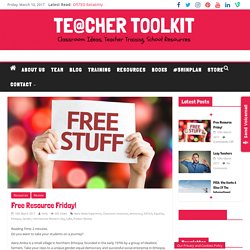
Do you want to take your students on a journey? Awra Amba is a small village in Northern Ethiopia, founded in the early 1970s by a group of idealistic farmers. Take your class to a unique gender-equal democracy and successful social enterprise in Ethiopia, with a free trial of this outstanding resource. Awra Amba – A thriving gender equal democracy The farmers, all illiterate at the time, set out to co-create a new society from scratch; where women and men would be treated as equals, and where everyone would have access to education and healthcare. The Main Idea Visible Learning for Teachers April 2013. A Century of Grading Research: Meaning and Value in the Most Common Educational Measure - Academic Commons. Title: A Century of Grading Research: Meaning and Value in the Most Common Educational Measure Author(s): Brookhart, Susan M.
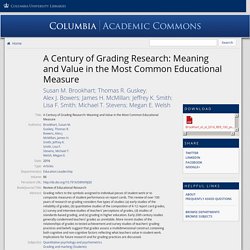
Guskey, Thomas R. Bowers, Alex J. How Students Critiquing One Another’s Work Raises The Quality Bar. Too often, when students produce school work, they turn it into a teacher for a grade and move on.
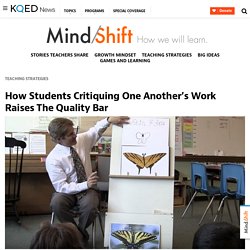
And after the teacher spends time evaluating the student’s work, many students never look at the feedback, a cycle that frustrates both parties and isn’t the most effective way to learn. Several schools are trying a different model — one that takes more time but also helps students feel more ownership over the quality of their work. Called peer critique, students follow clear protocols that remind them to “be kind, be specific, and be helpful” in the feedback they give to peers.
In the Edutopia video shown below about Two Rivers Charter School in Washington, D.C., students explain how through a process of revisions, they can feel proud about gradually producing high quality work. 5 Fantastic, Fast, Formative Assessment Tools. “We’ve got this, it’s easy,” they said. “Can we move on?” I looked at the other students and asked, “Do you have this?”
They nodded their heads furiously up and down in a yes. My teacher instincts said that everyone knew it, but I decided to experiment, so I wrote a problem on the board. Every Teacher’s Guide to Assessment. It’s not a stretch to say that assessment is a hot button issue in education; however, you’d be hard pressed to find an educator who doesn’t see the value in measuring student progress. Assessments themselves have been vilified, when, in fact, it’s why assessments are given and how the data is used that is really the issue. The Glossary of Education Reform gives this great overview of what high-stakes testing is and how it impacts students, teachers, and schools.
Basically, high-stakes testing has consequences for the test-takers and givers—sometimes in the form of a high school diploma, grade advancement, and even teachers’ salaries. But not all assessment is high-stakes, and when done thoughtfully, the right assessment can provide extremely useful information for all stakeholders—students, teachers, parents, schools, and policy-makers. The Inconvenient Truths About Assessment - TeachThought PD. The Inconvenient Truths About Assessment by Terry Heick For in-person professional development from TeachThought on effective assessment (or any other topic your school or district might need), contact us today.

Ed note: this post has been updated and republished from a March 2015 post 1. In terms of pedagogy, the primary purpose of an assessment is to provide data to revise planned instruction. On Flipboard. A classroom teacher’s guide to formative assessment. I’m working on a guide to formative assessment for classroom teachers.
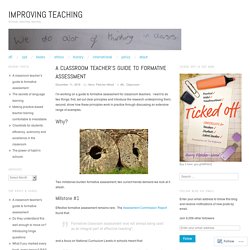
I want to do two things: first, set out clear principles and introduce the research underpinning them; second, show how these principles work in practice through discussing an extensive range of examples. Avoid over-reliance on tests and exams. Amid calls for a more holistic approach towards children’s development and learning, the recently announced changes in the scoring for the Primary School Leaving Examination (PSLE) are a welcome step in the right direction.
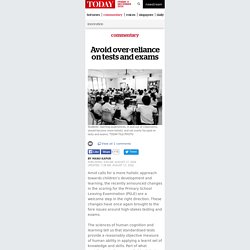
These changes have once again brought to the fore issues around high-stakes testing and exams. The sciences of human cognition and learning tell us that standardised tests provide a reasonably objective measure of human ability in applying a learnt set of knowledge and skills. Part of what contributes to the sense of objectivity is a seductive reduction of human ability to a quantifiable metric such as a percentage score or a letter grade. Yet, what often goes unnoticed is that this measurement is done under very controlled settings: Students take the test individually, in one sitting, over a short period of time, without the use of resources, and in settings largely removed from the settings in which that knowledge is to be applied.
Beyond Grades: Do Games Have a Future As Assessment Tools? Most tests represent a snapshot of one moment in the trajectory of a student’s academic journey, extrapolating what the student has learned overall.
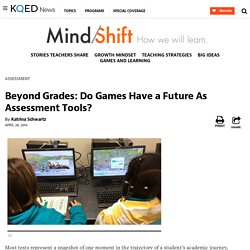
There are plenty of ways educators are trying to supplement those tests with more nuanced, formative assessments. With the advent of game-based learning, educators have been investigating how data collected from video game play could provide insight into the way students think as they explore new concepts. 6 EdTech Tools for Modernizing Assessment. By Jayme Cook Teaching and learning assessments have changed drastically over the past two decades. An Interesting Infographic on The Differences between Summative and Formative Assessment. June 9, 2016 After the huge interaction we received following the posting of ’12 Great Formative Assessment Tools for Teachers’ we decided to re-share with you this visual that we created almost two years ago.
The visual sums up some of the key differences between summative and formative assessment. Insights included here are based on Frey and Fisher's book " Literacy 2.0 : Reading and Writing in The 21st Century Classroom. " The illustrative examples are taken from Eberly Center page. Eight ways teachers can reduce their marking mountain. Edsurge. 10 images to share at your next faculty meeting.
60 Non-Threatening Formative Assessment Techniques. 60 Non-Threatening Formative Assessment Techniques by TeachThought Staff As frequently as a chef needs to check a sauce for taste, teachers should check for understanding. These can be formal–formative or summative assessment, multiple choice, short answer, essay, matching, and related iconic “test” forms. But they can also be informal–conversations, gallery walks, sketches, and more. We recently shared the Inconvenient Truths of Assessment, and one of the takeaways from that post by Terry Heick could be that rather focusing on the design of assessment, we could instead focus on a climate of assessment.
The 3 Stages of Documentation OF/FOR/AS Learning. Documentation OF/FOR/AS Learning has many objectives, goals, levels, and components. My work is concentrating on making pedagogical documentation visible and shareable to amplify teaching and learning. I believe that using technology, as a tool, to be able to share best practices, to make thinking and learning visible to ourselves and others, is the key to transform teaching and learning. Top 10 standards-based grading articles. The Almighty 'A' is the Death of Learning Grade inflation, helicopter parents, and students demanding unfounded grade raises can all be traced back to one thing -- worshipping at the Temple of "A". Part 2: Over 35 Formative Assessment Tools To Enhance Formative Learning Opportunities. Improving Your Grading Policy in Three Steps. By Jasper Fox Sr. Do We Really Want Feedback? Grading By Hand - Welcome to Flubaroo. 53 Ways to Check for Understanding.
The most simple and effective Evernote Tagging System - EuroProductive. Last week my friend Francesco D’Alessio reached the milestone of 500 subscribers for his YouTube Channel. Here Is A Handy Tool for Creating Rubrics to Use in Class. July 19, 2015 ForAllRubrics is another cool web tool for easily creating rubrics, checklists, and badges. The site provides a wide variety of interesting features for teachers including: the ability to score across different mobile devices, issue digital badges with evidence, view the status of your whole class at a glance, access assessment results on ForAllRubrics website, one click sharing of assessment results by email with students and parents and many more.
It's time to throw out grades @MsSackstein SmartBlogs. Resources for Assessment in Project-Based Learning. Children 'in complete meltdown' over exams. 5 Powerful iPad Apps to Enhance The Way You Grade Students Assignments. 33 Digital Tools for Advancing Formative Assessment in the Classroom. Assessment – How are we monitoring student learning and performance? What Believing in the Possibilities Can Do For Learning and Teaching.
18 Behaviors of Emotionally Intelligent People. The Best Music Creation Apps for Teachers. Education Week. Mobile phone bans improve school exam results, research shows. Education Week. How ‘Deprogramming’ Kids From How to ‘Do School’ Could Improve Learning. Story. 5 Fantastic, Fast, Formative Assessment Tools. The Best 8 Web Tools for Doing Formative Assessment in Class. This App Rewards Students For Not Looking At Their Phone During Class. 27 Teacher Actions That Help Promote Valid Assessment Data - Google Classroom: Share Classroom Folder. Resources for Assessment in Project-Based Learning. How To Create A Test That Grades Itself Using Google Forms. Educational Technology and Mobile Learning: ClassDojo Released 5 New Features for Teachers and Parents. Excellent Teacher-tested Tools to Help in Your Student Assessments. Exactly How A Learning Management System Can Improve Your Teaching. 7 Good Grading iPad Apps for Teachers.
Which Asian Test Prep Regime Would You Prefer? FIP Your School Ohio - Leading and Coaching FIP. Types of assessment - definitions - Support for students and staff - University of Exeter. Formative Assessment with Plickers. Will You Live to See the No-Grades Classroom? Important Tips On Using Google Forms to Grade Students. Assessment 3.0 in Action: Infographic. Assessment 3.0: 4 Simple Words that Will Revolutionize Learning. How grades fail to send the right message. Events in Instruction- Event #8.